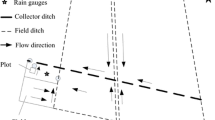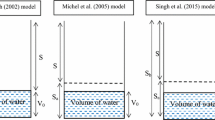Abstract
In one of the widely used methods to estimate surface runoff - Soil Conservation Service Curve Number (SCS-CN), the antecedent moisture condition (AMC) is categorized into three AMC levels causing irrational abrupt jumps in estimated runoff. A few improved SCS-CN methods have been developed to overcome several in-built inconsistencies in the soil moisture accounting (SMA) procedure that lies behind the SCS-CN method. However, these methods still inherit the structural inconsistency in the SMA procedure. In this study, a modified SCS-CN method was proposed based on the revised SMA procedure incorporating storm duration and a physical formulation for estimating antecedent soil moisture (V 0 ). The proposed formulation for V 0 estimation has shown a high degree of applicability in simulating the temporal pattern of soil moisture in the experimental plot. The modified method was calibrated and validated using a dataset of 189 storm-runoff events from two experimental watersheds in the Chinese Loess Plateau. The results indicated that the proposed method, which boosted the model efficiencies to 88% in both calibration and validation cases, performed better than the original SCS-CN and the Singh et al. (2015) method, a modified SCS-CN method based on SMA. The proposed method was then applied to a third watershed using the tabulated CN value and the parameters of the minimum infiltration rate (f c ) and coefficient (β) derived for the first two watersheds. The root mean square error between the measured and predicted runoff values was improved from 6 mm to 1 mm. Moreover, the parameter sensitivity analysis indicated that the potential maximum retention (S) parameter is the most sensitive, followed by f c . It can be concluded that the modified SCS-CN method, may predict surface runoff more accurately in the Chinese Loess Plateau.





Similar content being viewed by others
References
Arnold JG, Moriasi DN, Gassman PW, Abbaspour KC, White MJ, Srinivasan R, Santhi C, Harmel RD, Van Griensven A, Van Liew MW (2012) SWAT: Model use, calibration and validation. Transation of the Asabe 55:1491–1508
Babu PS, Mishra SK (2012) Improved SCS-CN–inspired model. J Hydrol Eng 17:1164–1172
Baginska B, Milne-Home W, Cornish PS (2003) Modelling nutrient transport in Currency Creek, NSW with AnnAGNPS and PEST. Environ Model Softw 18(8):801–808
Bhuyan SJ, Mankin KR, Koelliker JK (2003) Watershed-scale AMC selection for hydrologic modeling. Transactions of the ASAE 46:237–244
Brocca L, Melone F, Moramarco T (2008) On the estimation of antecedent wetness conditions in rainfall–runoff modelling. Hydrol Process 22:629–642
Famiglietti JS, Wood EF (1994) Multiscale modeling of spatially variable water and energy balance processes. Water Resour Res 11:3061–3078
FAO-UNESCO (1988) Soil map of the world. Revised Legend. Soil Bulletin No. 60, Rome.
Giakoumakis S, Stamouli P, Tigka D (2015) Evaluating a modified simple rainfall-runoff model in Mediterranean river basins. European Water 50:35–42
Grimaldi S, Petroselli A, Romano N (2013) Green-Ampt curve-number mixed procedure as an empirical tool for rainfall-runoff modelling in small and ungauged basins. Hydrol Process 27(8):1253–1264
Hawkins RH (1975) The importance of accurate curve numbers in the estimation of storm runoff. Water Resour Bull 11:887–891
Hawkins RH (1993) Asymptotic determination of runoff curve numbers from data. Journal of Irrigation and Drainage Engineering-ASCE 119:334
Hjelmfelt ATJ, Kramer KA, Burwell RE (1982) Curve numbers as random variables. In: Singh VP (ed) in proceeding. International Symposium on Rainfall-Runoff modelling. Water Resources Publication, Littleton, pp 365–373
Huang M, Gallichand J, Dong C, Wang Z, Shao M (2007) Use of soil moisture data and curve number method for estimating runoff in the loess plateau of China. Hydrol Process 21:1471–1481
Huang M, Gallichand J, Wang Z, Goulet M (2006) A modification to the soil conservation service curve number method for steep slopes in the loess plateau of China. Hydrol Process 20:579–589
Jain MK, Mishra SK, Babu PS, Venugopal K (2006) On the Ia–S relation of the SCS-CN method. Hydrol Res 37(3):261–275
Jiao P, Xu D, Wang S, Yu Y, Han S (2015) Improved SCS-CN method based on storage and depletion of antecedent daily precipitation. Water Resour Manag 29:4753–4765
Kaffas K, Hrissanthou V (2015) Estimate of continuous sediment graphs in a basin, using a composite mathematical model. Environmatal Processes 2:361–378
King KW, Arnold JK, Bingner RL (1999) Comparison of green-Ampt and curve number methods on Goodwin Creek watershed using SWAT. Transactions of the ASAE 42:919–925
Marquardt DW (1963) An algorithm for least-squares estimation of nonlinear parameters. Journal of the Society for Industial and Applied Mathematics 11:431–441
Mdee OJ (2015) Spatial distribution of runoff in ungauged catchments in Tanzania. Water Utility Journal 9:61–70
Michel C, Andréassian V, Perrin C (2005) Soil conservation service curve number method: how to mend a wrong soil moisture accounting procedure? Water Resour Res 41:1–6
Mishra SK, Jain MK, Suresh Babu P, Venugopal K, Kaliappan S (2008) Comparison of AMC-dependent CN-conversion formulae. Water Resour Manag 22:1409–1420
Mishra SK, Sahu RK, Eldho TI, Jain MK (2006) An improved Ia-S relation incorporating antecedent moisture in SCS-CN methodology. Water Resour Manag 20:643–660
Mishra SK, Singh VP (2002) SCS-CN-based hydrologic simulation package. In Ch. 13: mathematical models in small watershed hydrology and applications, Singh VP, Frevert DK (eds). Water resources publications: Littleton. CO 80161:391–464
Narsimlu B, Gosain AK, Chahar BR, Singh SK, Srivastava PK (2015) SWAT model calibration and uncertainty analysis for streamflow prediction in the Kunwari River basin, India, using sequential uncertainty fitting. Environmantal Processes 2:79–95
Penman HL (1948) Natural evaporation from open water, bare soil and grass. Proc R Soc Lond A 193:120–145
Ponce VM, Hawkins RH (1996) Runoff curve number: has it reached maturity? J Hydrol Eng ASCE 1:11–19
Risse LM, Nearing MA, Savabi MR (1994) Determining the green-Ampt effective hydraulic conductivity from rainfall-runoff data for the WEEP model. Transactions of the ASAE 37:411–418
Sahu RK, Mishra SK, Eldho TI (2010) An improved AMC-coupled runoff curve number model. Hydrol Process 24:2834–2839
Sahu RK, Mishra SK, Eldho TI (2012) Improved storm duration and antecedent moisture condition coupled SCS-CN concept-based model. J Hydrol Eng 17:1173–1179
SCS (1972) National Engineering Handbook, section 4. Soil Conservation Service USDA, Washington, DC
Shao M, Li K, Zhong L (1991) Predicting the hydraulic conductivity and water diffusivity of unsaturated soils from the soil water characteristic cureves. Research of Soil and Water Conservation 1:26–32 (in Chinese)
Sharpley AN, Williams JR (1990) EPIC-erosion/productivity impact calculator: 1. Model documentation. U.S. Department of Agriculture Technical Bulletin No. 1768, U.S. Government Printing Office, Washington, DC.
Shi ZH, Chen LD, Fang NF, Qin DF, Cai CF (2009) Research on the SCS-CN initial abstraction ratio using rainfall-runoff event analysis in the three gorges area, China. Catena 77:1–7
Singh PK, Gaur ML, Mishra SK, Rawat SS (2010) An updated hydrological review on recent advancements in soil conservation service-curve number technique. Journal of Water and Climate Change 1(2):118–134
Singh PK, Mishra SK, Berndtsson R, Jain MK, Pandey RP (2015) Development of a modified SMA based MSCS-CN model for runoff estimation. Water Resour Manag 29:4111–4127
The Shanxi Institute of Soil and Water Conservation (1970) Hydrological data at Zizhou Experimental Station of the Yellow River from 1959 to 1969. The Yellow River Administration Committee Press, Zhengzhou
The Yellow River Administration Committee of Ministry of Water Resources (1981) Hydrological data at Suide Experimental Station of the Yellow River from 1959 to 1980. The Yellow River Administration Committee Press, Zhengzhou
Tigkas D, Tsakiris G (2004) Medbasin: a Mediterranean rainfall–runoff software package. European Water 5(6):3–11
Van Mullen JA (1991) Runoff and peak discharges using green-Ampt infiltration model. J Hydraul Eng ASCE 117:354–370
Yang W, Shao M (2000) Soil water in the loess plateau. Science Press, Beijing (in Chinese)
Acknowledgements
This research was jointly supported by NSFC and the NERC Newton Fund through the China-UK collaborative research on critical zone science (No. 41571130082 and NE/N007433/1).
Author information
Authors and Affiliations
Corresponding author
Rights and permissions
About this article
Cite this article
Shi, W., Huang, M., Gongadze, K. et al. A Modified SCS-CN Method Incorporating Storm Duration and Antecedent Soil Moisture Estimation for Runoff Prediction. Water Resour Manage 31, 1713–1727 (2017). https://doi.org/10.1007/s11269-017-1610-0
Received:
Accepted:
Published:
Issue Date:
DOI: https://doi.org/10.1007/s11269-017-1610-0




